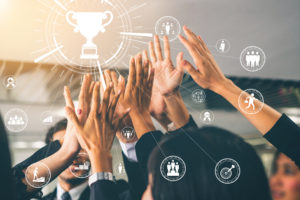Nature’s balance reflects interdependence
We all learned in school that animals breathe in oxygen and exhale carbon dioxide – toxic for us – while plants and trees breathe in CO2 and give off the oxygen animals (including us humans) need to survive. What an amazing balance of supply and demand to meet the survival needs of both the plant and animal kingdoms.
Of course, we know this is not simply a serendipitous coincidence – life on earth evolved this way because it couldn’t evolve in a way that was not in balance. While this is a gross oversimplification (and we apologize to paleobiologists and Charles Darwin), ancient plants evolved because they sucked in carbon dioxide and provided the oxygen that allowed ancient animals to survive and evolve – and vice versa.
Fast-forward to the amazing diversity of plants and animals on earth today and reflect on the balance nature has achieved in response to the resources that had been available up to now. But evolution is a never-ending feedback loop that reacts to a change in the available resources. The resources that created all of life as we know it are being thrown badly out of balance. Plant and animal species are going extinct at an unprecedented rate, which is reducing the diversity of life on our planet, known as biodiversity.
Nature means business
We don’t mean to get preachy here, but we do think it is important to get real. Biodiversity is declining because of human activity – according to the World Economic Forum (WEF), humans have caused the loss of 83% of all wild animals and half of all plants. That is already affecting the way we live our lives, including the types and availability of the foods we like to eat, medicines we have yet to discover, and how businesses operate – businesses that employ people and offer investors opportunities to earn a return on their capital (think of tourist businesses that rely on thriving coral reefs, seafood companies that rely on declining fish populations, and the entire agricultural industry).
But don’t assume that biodiversity risks apply only to sectors like agriculture and tourism. We’re quoting from an article from the Corporate Eco Forum here: “According to the WEF, more than half of the global gross domestic product depends on nature, and the United Nations Environment Programme Finance Initiative found that 13 of the 18 sectors that comprise the FTSE 100 — representing US$1.6 trillion in market capitalization – are associated with production processes with high or very high material dependence on nature” (emphasis is ours – actually, we want to emphasize the entire article). In other words, businesses and investors need to take biodiversity seriously.
While most countries and companies now recognize that climate change poses a very real threat to humans, and therefore to business profitability and sustainability, we’re not there yet in terms of recognizing the impact of a loss of biodiversity. Fortunately, awareness is growing. In June 2022, the Taskforce on Nature-related Financial Disclosures (TNFD) released a new beta version of its “market-led, science-based” framework that will “enable companies and financial institutions to integrate nature into decision making” (you can review the latest version here). In December 2022, governments from around the world will meet in Montreal, Canada at a U.N. Biodiversity Conference to “agree on a new set of goals to guide global actions through 2040 to protect and restore nature.”
Let’s hope the TNFD and the U.N. grab attention and inspire businesses, consumers and investors everywhere (in other words, you and me and everyone we know, and everyone they know) to take action to protect and restore biodiversity. As the TNFD clearly states, “Nature loss poses a major risk to businesses, while moving to nature-positive investments offers opportunity.” There is no time to lose, and everything to gain.




